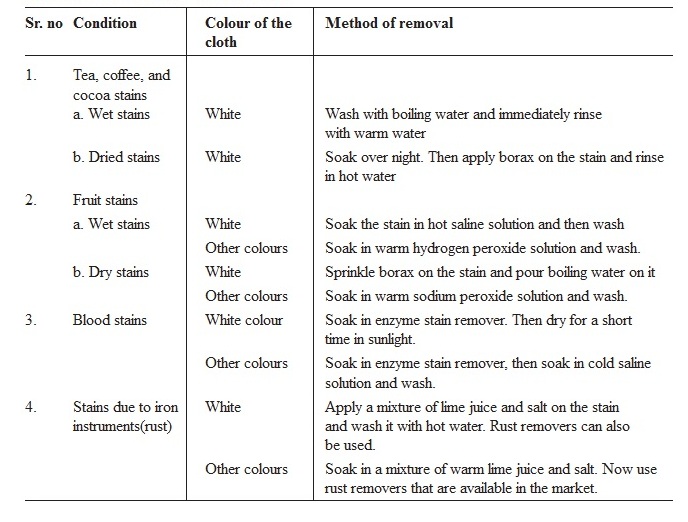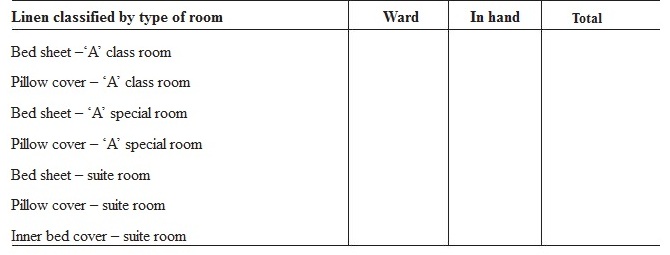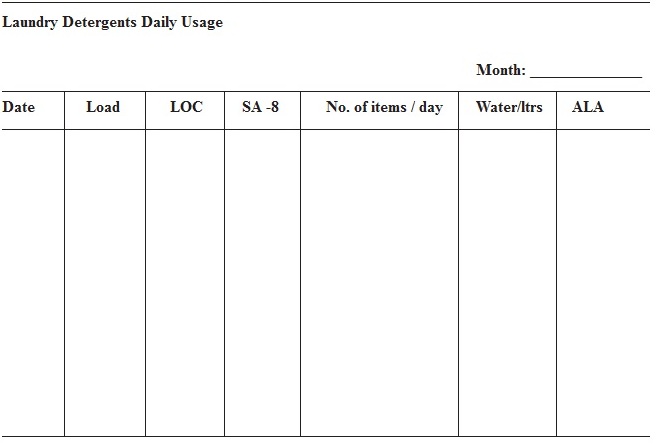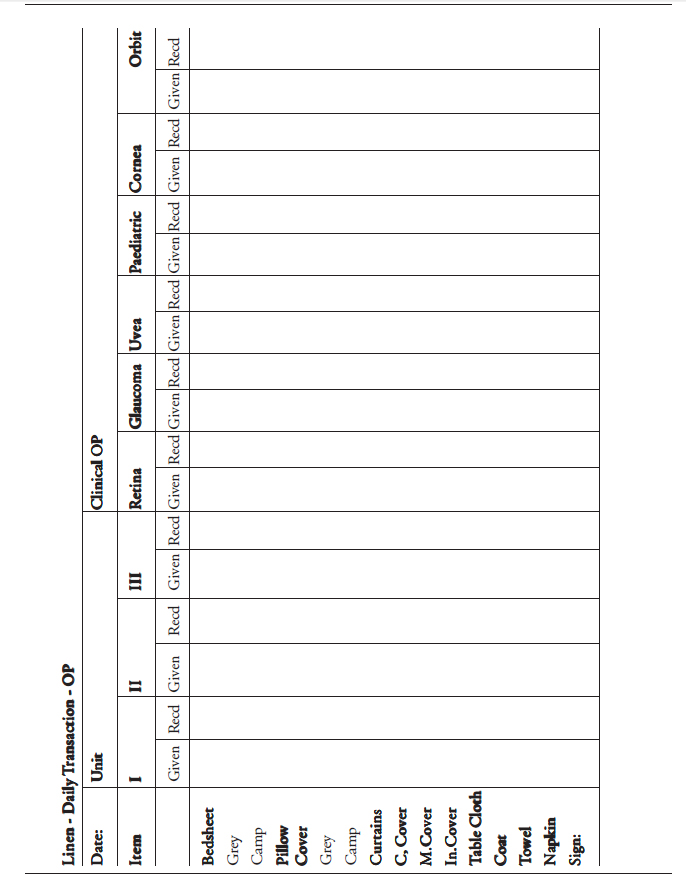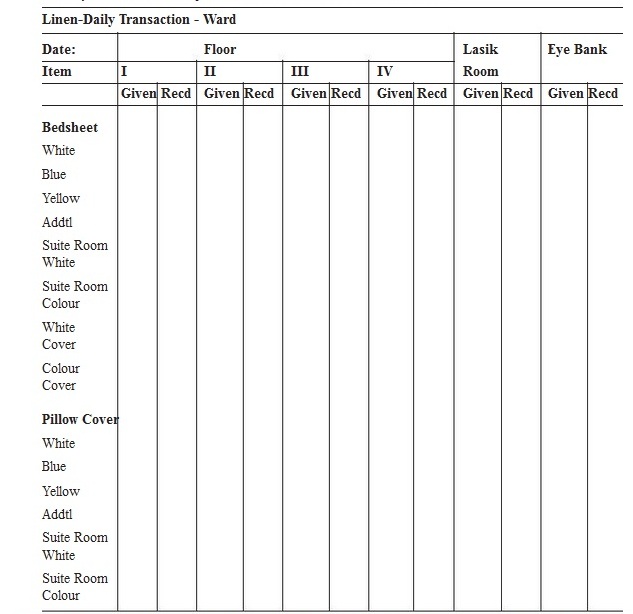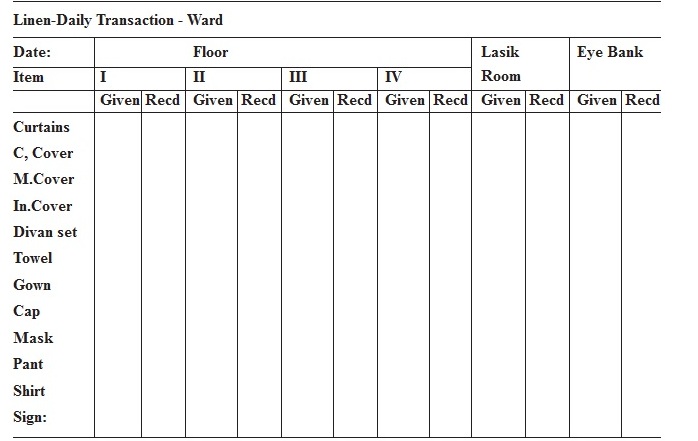Setting up a linen department
Linen forms an integral part of any hospital. Providing clean and fresh linen is an important task of housekeeping. Maintaining linen is a full-time job, and hence the linen department may be looked upon as a department in itself.
The linen department needs a large area, where the entire linen of the hospital is stored. This should be situated near the laundry so as to make it easy to control the movement of linen from different areas of the hospital to the laundry and back.
The cupboards storing the linen should be neatly labeled, both on the inside and outside, indicating the linen and the area to which the linen belongs. To ensure the smooth functioning of the linen department, par stock should be maintained. (Par stock means three to four times the quantity of linen required for the hospital.) Regular stocks have to be maintained in a register specially designed for this purpose.
The linen that comes for washing should be scrutinized daily for damage. The regular life of linen is about 250 washes, or 2-3 years, after which the linen should be condemned, and new linen bought to replace the condemned linen. This condemnation should be carried out monthly, and a record maintained in the stock register.The condemned linen can be recycled as cloth dusters.
The housekeeper assigned to this department has the following role to play:
-Maintaining a daily account of soiled linen received from the different areas of the hospital, and the fresh linen issued to the different areas.
-Ensuring that infected and stained linen is sterilized and washed separately
-Ensuring that the linen is washed under hygienic conditions and returns stain-free from the washing area
-Maintaining the stock register
-Repairing damaged linen immediately
-Checking linen every month and separating the linen which needs to be condemned
-Regularly checking on the detergents and cleaning agents available in the market to ensure that the detergents used are good and cost-effective
-Stocking all the linen systematically in cupboards provided for the purpose
Selecting linen for the hospital
When setting up a linen department, the first thing to look into is the requirement of linen for the hospital. In the wards, for a multi-speciality hospital, the ratio is 1:4 (4sets per bed) while in a single speciality hospital 1:3 (3 sets per bed).Then comes the requirement for the OT, OP and other areas.
Colour coding and quality of the linen is next in the decision making process. Colour coding may be done department-wise, or room-wise, as the management deems fit. Choose colours that will not bleed. Choose colours that are soothing to the eye.The quality of linen should be good, so that it is easy to maintain. By cutting costs and opting for cheap linen we may be the losers in the long run.The cloth will give way soon, or may become rough and difficult to use. When purchasing linen it is always best to first obtain samples that may be tested for quality and strength.
Setting up a system for linen management
One of the important jobs of the housekeeping department is clothes and linen management. In a hospital different types of clothes are used. The outer gowns worn by doctors and patients, the bed sheets, blankets, pillow covers and pillows are to be washed, cleaned and maintained properly. This is one of the most important jobs of a housekeeper. Other than this, napkins, curtains and seat covers have to be laundered. Maintaining the cleanliness of clothes and linen will prevent the spread of disease
Dirty bed sheets should be folded to prevent dust from flying about.The clothes that need to be washed from different rooms should be put into their respective laundry bags and brought to the laundry.
In the laundry they should be sorted out according to their condition and type. Torn clothes, good clothes, clothes with blood stains, clothes with rust stains, should be sorted out and kept separately. Torn sheets and clothes should be mended. In case they are very badly torn and cannot be mended, they should be condemned. These condemned clothes should be recycled and used as dusters.
Clothes should also be separated type-wise, that is, bed sheets, pillow covers, towels, curtains, doctors’ gowns and coats, and then sent to the washing machine.
Clothes stained with blood or body fluids should be washed separately by hand and the stains should be removed. Deal with this kind of stain as soon as possible, the longer you wait the more time the stain has to soak in /or dry, making it more difficult to remove. After that the linen should be soaked and rinsed in dettol or disinfectant mixed water and then dried in direct sunlight. Only then they should be sent to the laundry for the regular wash.
After the clothes are washed and returned to the linen room, they have to be sorted out according to area, and type, and sent to the different user departments. The extra clothes have to be put back into the cupboard in the allotted places. Both when receiving the clothes and while distributing them a
clear record of clothes given and received should be maintained.This helps in tracking the missing clothes.
Selecting the right cleaning agents and detergents
As with materials and equipment, care should be taken to select detergents that are not harsh on the clothes, yet clean well. Avoid the use of bleaching agents as they tend to corrode the cloth and the clothes wear out faster than they should. While selecting detergents, the cost factor should also be kept in mind, although it is wiser to go for a costlier detergent if it is giving you better results and helps in making the clothes last longer.
Washing the clothes
The washing machine in the hospital is an electrical device. At a time, 30 bed sheets, 70 pillow covers, or 25 curtains can be washed in the machine (Fig.14.1).
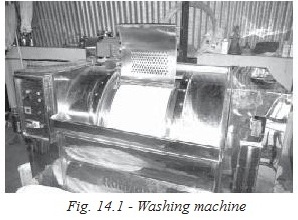
Equipment and materials
Detergent as recommended for washing a load of 30 bed sheets.
Procedure
-Remove all stains on the clothes before loading them into the washing machine. The chart below gives different methods adopted to remove different kinds of stains
-Take the required amount of detergent and dissolve it in water
-Pour this solution into the machine
-The clothes that have been sorted out should be put into the machine type-wise
-The first round of washing should not exceed 25 minutes
-In the second round the clothes should be rinsed with an adequate amount of water. This round should not exceed 10 minutes
-In the third round rinse the clothes again with clean water for 10 minutes
-Now put the clothes into the extractor and remove them
-Put the washed clothes out to dry in direct sunlight
-When the clothes are absolutely dry, they should be ironed, folded and neatly stored in the cupboard (Fig. 14.2 & Fig. 14.3)
-Clothes such as napkins, doctors’ coats and gowns should not be put into the machine. They should be hand washed
-A stock register of the clothes in the cupboard must be maintained. Entries should be regularly made
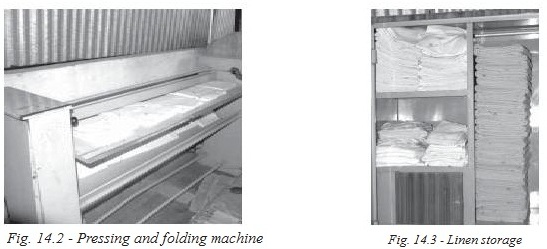
Cleaning mats and pillows
In the free section of some eye hospitals , mats and pillows are provided to the patients to rest. These mats and pillows can get stained on account of vomit, loose motions, or blood. This provides an excellent breeding ground for germs. To avoid this and to keep these mats and pillows clean and hygienic, mix 100ml of dettol in 5litres of water. Rinse the mats and
pillows and wash them with clean water every time a patient is discharged. Then rinse them in this dettol solution. Dettol helps to kill the germs present and makes the mats and pillows hygienically clean. After rinsing the mats and pillows in the dettol solution, dry them thoroughly in direct sunlight. The dried mats and pillows should be piled together and tied until required.
Dry cleaning
Silk clothes, clothes with glass work, and other costly clothes should be dry cleaned.
Time allotted for washing
-Each type of cloth should be washed according to its usage
-The bed sheet, pillow covers, bed spread in the in patient’s room should be changed every alternate day. Used linen should be removed and replaced with fresh linen
-Linen should be changed immediately if it is stained with blood or body fluid
-For patients with ulcers and oozing sores, the linen should be changed every day
-Table cloths and doctor’s coats should be washed once a week
-Hand towels should be washed daily
-Curtains should be washed once a month
-The mattress cover should be washed once in six months or whenever stained


